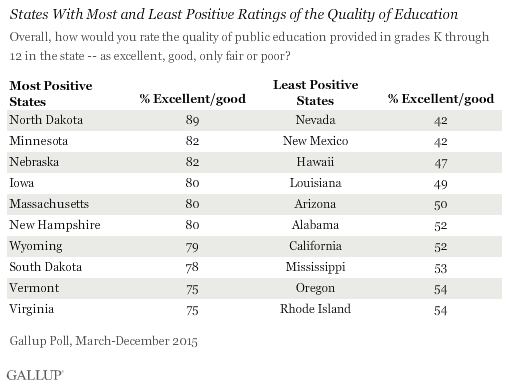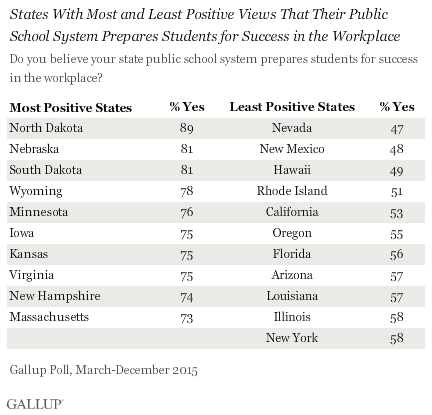Story Highlights
- 89% of North Dakota residents rate schools as excellent or good
- Nevada and New Mexico residents least positive about their schools
- Residents see link between quality K-12 education and workplace success
WASHINGTON, D.C. -- North Dakota residents (89%) are more likely than those living in any other U.S. state to rate the K-12 education provided in their state as excellent or good, followed closely by those living in Minnesota and Nebraska. In stark contrast, about half as many Nevada and New Mexico residents, 42% in each, rate their public education systems positively.

North Dakota also ranked at the top when Gallup first measured state residents' perceptions of public education quality in 2013, while Nevada and New Mexico were at the bottom.
These results are based on a Gallup poll conducted March 30-Dec. 22, 2015, with approximately 500 interviews in every state. Full results for each state appear at the end of the article.
North Dakota Residents Report School System Prepares Students for Workplace Success
Residents in states where a large share of residents rate the quality of education as excellent or good are also more likely to believe their public school system prepares students for success in the workplace. About nine in 10 North Dakota residents report their public school system prepares students for success in the workplace. Nebraska and South Dakota residents follow closely behind at 81%. On the other end of the spectrum, less than half of Nevada, New Mexico and Hawaii residents feel that their state education system prepares students for workplace success.
There is a moderate relationship between unemployment rates and residents' perceptions that their public education system prepares students for workplace success. In December 2015, North Dakota, Nebraska and South Dakota -- states with positive perceptions of public education -- had the three lowest unemployment rates among all states and the District of Columbia, according to the Bureau of Labor Statistics. Nevada and New Mexico -- the two states with the least positive perceptions of schools -- had significantly higher unemployment rates and ranked 46th and 48th in December 2015 among all 50 states and the District of Columbia.

Implications
Gallup data reveal a strong relationship between states' economic conditions and residents' perceptions that their public education systems are providing high-quality education that will prepare students for workplace success. Public education systems require strong financial support at the state and local level, and challenging economic conditions can make it more difficult to provide the funding required for schools to deliver a high-quality education. Additionally, students living in states with higher unemployment rates may face different challenges in finding a good job.
Nationally, leaders continuously suggest programmatic changes to improve the quality of education in the U.S. Gallup data suggest that Americans believe a key component of a high-quality education is providing students with skills that can easily transfer to the workplace.
Survey Methods
Results for this Gallup poll are based on telephone interviews conducted March 30-Dec. 22, 2015, with random samples of approximately 500 adults, aged 18 and older, living in each of the 50 U.S. states. Data are weighted to account for unequal selection probability, nonresponse and double coverage of landline and cellphone users in the two sampling frames. Data are also weighted to state estimates of gender, age, race, Hispanic ethnicity, education and phone status (cellphone only, landline only, both and cellphone mostly).
For results based on the total sample of adults in each state, the margin of sampling error is ±6 percentage points at the 95% confidence level. All reported margins of sampling error include computed design effects for weighting.
Each state sample includes roughly 60% cellphone respondents and 40% landline respondents. Landline and cellular telephone numbers are selected using random-digit-dial methods.





